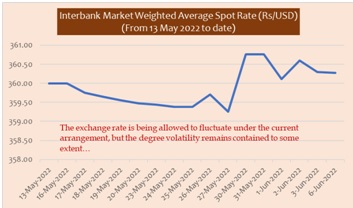This note is intended to explain to the general public the background to the current exchange rate arrangement, and the positive impact it has already made, and expected outcomes in the period ahead.
The country is facing extremely challenging economic circumstances at present while it is going through the worst balance of payments crisis in history. The Sri Lanka rupee was subject to tremendous depreciation pressure, amidst the shortage of foreign exchange liquidity in the domestic foreign exchange market, warranting a measured adjustment in the determination of the exchange rate in early March 2022, compared to the level that prevailed in the market amidst concerns about the adverse impact of any large depreciation of the exchange rate on the society. However, the outcome of the exchange rate flexibility that was thereafter allowed following the initial measured adjustment fell short of expectations due to the large overshooting by market forces, reflecting the significant liquidity pressures that prevailed in the domestic foreign exchange market as well as the delay in market correction. This behaviour of exchange rate since allowing more flexibility in March 2022 suggests the need for careful sequencing of measures when allowing flexibility in exchange rate under balance of payments crisis conditions.
Following the excessive depreciation, inflation accelerated significantly through imported prices, while second-round effects of such excessive depreciation on other goods and services were also observed subsequently. Moreover, due to the acute shortage of foreign exchange in the domestic foreign exchange market, along with continuous depreciation of exchange rate, the conversions of foreign exchange by the foreign exchange holders delayed due to expectation of further depreciation and high premium offered in the grey market, thus adding further pressures on the currency. Meanwhile, the demand for foreign exchange in the grey market thrived to part finance rising import demand outside the banking system, causing further pressures on the currency as well as heightening stresses in the banking system. This significant volatility of the exchange rates drove up the interbank exchange rates as well as customer buying and selling rates in an abrupt nature, causing undue speculation on the currency.
Against this backdrop, limiting the extent of depreciation and excessive volatility became necessary. If remained unresolved, such boundless rate of depreciation of the exchange rate could have led to extremely detrimental impact on overall macroeconomic stability, given the severity of the balance of payment crisis that the country is going through at the moment. Further, during the discussions with the Heads of Treasuries of licensed commercial banks, the need for some guidance to the market from the Central Bank on the degree of volatility of the exchange rate movements was emphasized, while the commercial banks have the prerogative to determine the interbank spot market exchange rate.
In consultation with the market players, the Central Bank commenced providing daily guidance on the degree of volatility (with an allowable two-sided variation margin) to all licensed commercial banks from 13 May 2022 based on exchange rate determined in the interbank market on the preceding day. Although this arrangement is often misinterpreted as ‘pegged exchange rate’ regime, there are clear distinctions between the current transitory arrangement and the pegged exchange rate system. Under the pegged exchange rate regime a fixed middle rate is usually dictated by a central bank, while market driven variable spot rate being considered as the middle rate under the current arrangement. The implementation of this arrangement has brought in a greater stability in the exchange rate determination in both formal market and grey market thus far, while also minimizing excessive margins prevailed in both markets, and the effects of the same are expected to reflect in the exchange rates used for customer transactions. According to the feedback received from the stakeholders, there exists broader consensus on the current arrangement of the exchange rate, which is market driven with less volatility and more predictability, compared to the earlier arrangement, which experienced excessively volatile of the exchange rate driven more by speculation rather than market forces and economic fundamentals.

The Government and the Central Bank implemented several complementary measures, alongside the current exchange rate arrangement, to correct some of the imbalances observed in the external sector, thereby bringing about stability in the domestic foreign exchange market. Restrictions imposed on open accounts and consignment payments terms have helped curtail activity in the grey market, thereby narrowing the gap between the official exchange rate and the grey market rate. Accordingly, the current exchange rate arrangement is viewed as a more credible mechanism, vis-a-vis an arrangement where grey market activity could operate freely. Consequently, inflows on account of workers’ remittances to the banking system have gathered pace since the introduction of the new exchange rate arrangement, while conversions have improved. Import expenditure has declined notably in May 2022, compared to April 2022, according to provisional data from Sri Lanka Customs. Despite the reduction in import expenditure, all possible measures would be taken to secure availability of essential commodities with the expected inflows from multilateral and bilateral sources to the banking system in the period ahead. Given the degree of overshooting of the exchange rate in March 2022, a further market based correction is expected with the deceleration of non urgent import expenditure, alongside increasing inflows to the banking system in terms of workers’ remittances and export proceeds on goods and services, among others.
This improved momentum in the domestic foreign exchange market is expected to consolidate with the progress being made towards reaching the staff level agreement with the International Monetary Fund (IMF) on a funding arrangement, along with the negotiations for bridging finance from other multilateral and bilateral partners. The Central Bank would like to reiterate that the current arrangement of exchange rate would be reviewed from time to time, and further flexibility would be allowed if need be, once market confidence is restored, supported by envisaged foreign exchange inflows to the country.










